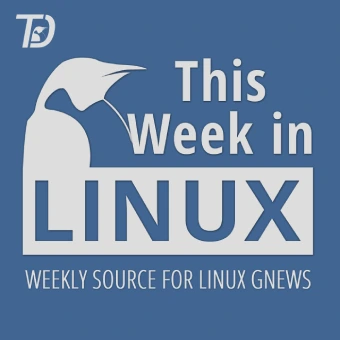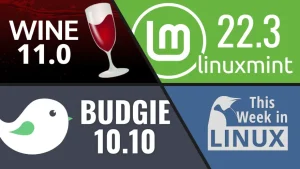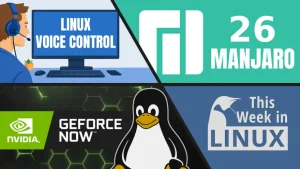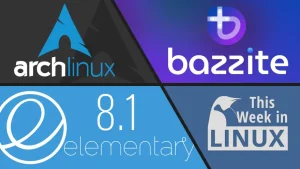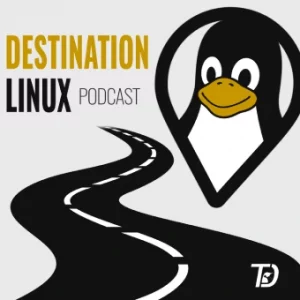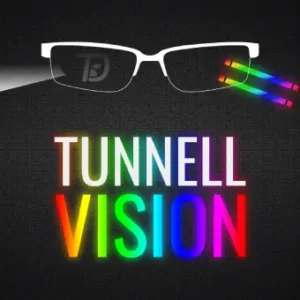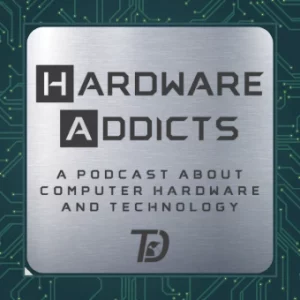This week in Linux, we saw a lot of good news this week because we have the latest release of Ubuntu 24.10. We also have a new release of KDE Plasma with 6.2. And there’s also some news with KDE Neon as well as Kubuntu. And we even have some drama news with the Linux kernel. All of this and more on This Week in Linux, the weekly news show that keeps you up to date with what’s going on in the Linux and Open Source world. Now, let’s jump right into Your Source for Linux GNews.
Support the Show
Become a Patron = tuxdigital.com/membership
Store = tuxdigital.com/store
Chapters:
00:00 Intro
00:38 Ubuntu 24.10 Released
07:10 Kubuntu 24.10 Released
10:37 KDE Plasma 6.2 Released
13:13 KDE neon 24.04 Released
15:37 Firefox Critical Vulnerability Found, Update Now
17:14 Ardour 8.9 Released
19:18 Linux Drama Alert
25:57 Support the show
Links:
- Ubuntu 24.10 Released
- Kubuntu 24.10 Released
- KDE Plasma 6.2 Released
- KDE neon 24.04 Released
- Firefox Critical Vulnerability Found, Update Now
- Ardour 8.9 Released
- Linux Drama Alert
- Support the show
Full Episode Transcript
Michael:
[0:00] This week in Linux, we saw a lot of good news this week because we have the latest release of Ubuntu 24.10. We also have a new release of KDE Plasma with 6.2. And there’s also some news with KDE Neon as well as Kubuntu. And we even have some drama news with the Linux kernel. All of this and more on This Week in Linux, the weekly news show that keeps you up to date with what’s going on in the Linux and Open Source world. Now, let’s jump right into Your Source for Linux GNews.
Michael:
[0:38] Canonical has announced the release of Ubuntu 24.10 codenamed Oracular Oriole. As with every new release of Ubuntu, there has been six months of development to update packages, tool chains, and more. This release comes with a update to the GNOME desktop with GNOME 47. There are a lot of nice improvements that have been added for GNOME 47, like the new accent colors, though that won’t seem like it’s much new for Ubuntu users because they’ve already had that for a couple of years, and that’s true. But GNOME 47 also introduces some updates for the file manager of Nautilus and many other enhancements, such as just the overall polish of improving the design for the dialogue popups.
Michael:
[1:24] We already went in-depth on GNOME 47, so if you would like to learn more, you can go check out TWIL 278, because we’re going to focus on Ubuntu in this particular episode, but if you’d like, we’ll have a link in the show notes to find more information about the latest release of the GNOME desktop. Now, the most notable thing to talk about with Ubuntu 24.10 is easily the change to the kernel selection for Ubuntu releases going forward, now and in the future. Ubuntu 24.10 is coming with Linux 6.11 kernel, and this is surprising because it was expected to be the Linux 6.10 kernel. We talked about Ubuntu’s new kernel selection process in TWIL 276, so to check out the full details for why, you can check out that episode, but the gist of it is that Ubuntu will now select the latest release kernel available at the time of releasing their latest version of Ubuntu, instead of locking it down during the feature freeze, which typically happened and resulted in a six month delay for updates of what was already available for like hardware support and that sort of thing. There will still be a delay, but it will be slightly better than it was before, which is always great.
Michael:
[2:34] Now, Linux 6.11 brings the usual mountain of changes ranging from new hardware support, security fixes, and expanded support for ARM and RISC-V chipsets, to a performance boost to the Extended 4 or EXT4 file system, and better power efficiency for newer AMD systems. Ubuntu 24.10 also comes with Mesa 24.2.3 graphics driver series and has support for 550.x and 560.x graphic drivers for NVIDIA users. Speaking of NVIDIA users, Ubuntu 24.10 will be defaulting to Wayland on devices with NVIDIA GPUs for the first time ever. Because canonical engineers say that they are confident this experience is robust enough for day to day usage.
Michael:
[3:20] Likely won’t be perfect for everyone, but you can say that pretty much now about both Wayland and Xorg really for about everyone. If a user wants to switch to Xorg from Wayland for whatever reason, they’ll still be able to do that in the login screen. There’s a new security app in this release that currently offers the new features for snap permissions. So users can control what level of access snaps have on their system. More features are planned for the security center for future releases of Ubuntu, including firewall configuration controls and easier enrolling for Ubuntu Pro for LTS users to access additional security updates and more. Ubuntu 24.10 also comes with better power efficiency with a new version of Power Profiles Daemon, which enables the power mode options in quick settings to work. It also provides improvements for AMD users as the The AMD P-State integration enables setting dynamic power management or DPM clock speeds on power saving mode, and it now supports for adjusting display backlight based on battery percentage, which is very nice. So you can have it automatically adjust the backlight based on what battery percentage you have.
Michael:
[4:29] Also with Ubuntu 24.10, it comes with a new apt 3.0 tool for an improved UI and UX, as it now uses colors, columns, and white space, which is padding and spacing for improved readability. The output of actions is now displayed by priority order. So packages removals are listed at the bottom close to where they ask you to continue or not and displayed as a red text. So as an attempt to make them harder to miss. This release also improves PPA security.
Michael:
[5:01] Apt now requires stronger signatures for PPAs and other repositories. Finally, there are some fun Easter eggs in this release to celebrate the 20th anniversary of Ubuntu.
Michael:
[5:11] Ubuntu’s first release was 4.10 in 2004. And now 20 years later, we are celebrating the anniversary because Ubuntu is one of the first distros to make Linux a user-friendly experience. Sure, there were others who attempted it before Ubuntu. but in my opinion, Ubuntu was the first to actually accomplish this goal. I first started with Linux before Ubuntu existed, but it was Ubuntu that got me to fully switch to Linux as my daily driver. And I love the fact that they are doing these Easter eggs because it’s just a nice fun thing to add to celebrate the accomplishment. They even brought back some visuals, the wallpaper, the design, the accent colors, all sorts of stuff to be similar to what it used to be, as well as bringing back a login sound from the original release. So if you want to use that, you can. Although it’s not the sound that most people think most of when they hear it, or if you’ve been around for Ubuntu, they had one that was long for a very long time, and then they had one that was there just in the early stages. So they brought back the original login sound, which was on 4.10, which was this.
Michael:
[6:32] And while it was nice and gives the angelic ethereal vibe the one i remember is the one with the drums which is this one there’s a lot more to the release of 24.10 but that’s all we have time for so you can find links in the show notes for more details and of course there are also the ubuntu flavor releases but unfortunately we do not have time to cover them in this episode so as is tradition, we’ll take a look at all of the flavors next week, though this week there is
Michael:
[7:07] one we’re going to cover and that’s Kubuntu. Kubuntu 24.10 has been released along with all of the other flavors. And while all of the flavors have a lot to talk about, I just couldn’t wait until next week for this release of Kubuntu because the reason is that Kubuntu 24.10 now includes KDE Plasma 6, or more specifically, Plasma 6.1. This is awesome because it means that the weird limbo of what KDE Plasma-based distro to suggest is no longer a problem. We now have Plasma 6 in Kubuntu. Kubuntu 24.04 was released with the latest version of Plasma 5, and while that made sense, it was an LTS release of a Plasma for an LTS release of version of Kubuntu, and so it made sense.
Michael:
[7:56] And Plasma 6 had only been out for less than two months at the time of release for Kubuntu 24.04, so the decision to wait, you know, made sense. But also, I wanted the new hotness, so I didn’t like the fact that they just, I get it, but also I wanted new hotness, okay?
Michael:
[8:16] What do I mean about the KDE Limbo thing? Well, I made a short about this on the channel because until now, we were in a weird state of what KDE distro to suggest. Kibuntu 24.04 was Plasma 5, which made sense. Most people wanted Plasma 6, though.
Michael:
[8:34] But Fedora KDE, which is fantastic, shipped with Waylon only. It did have Plasma 6, but it was only Waylon in Fedora 40. So that means there might have been some issues for some people. So this made it harder to suggest to beginners. Now, KDE Neon is just not meant for daily use for most people, as it’s more of a development playground. And I mean, they even say this is not a distro. So, you know, take that as you will. OpenSUSE had Leap, which was Plasma 5, and Tumbleweed had Plasma 6, but it also moves way too fast for beginners. And Slow Roll is a thing, but it’s still very early stages of that particular version. So it became an interesting question. If someone wanted to try KDE Plasma for the first time, which distro would you send them to? And honestly when i made that short the answer that i landed on was i don’t know now though that problem is solved and we now have kubuntu 24.10 with plasma 6. All is now right in the kde world additionally kubuntu 24.10 comes with linux 6.11 kernel of course inheriting it from the ubuntu 24.10 base and another big change for kubuntu is that whalen is now going to be the default display manager out of the box, but those who still want to use X11 can switch to it during the login screen. Personally, I’m excited for Kubuntu 24.10 because of course.
Michael:
[10:04] The use of KDE Plasma 6 is great, the new hotness, and now the problem with which KDE-based distro should beginners use is now solved. It’s Kubuntu. Now that Kubuntu has KDE Plasma 6.1, let’s talk about KDE Plasma 6.2. But first, a really quick note, Kubuntu has 6.1 because 6.2 was released two days before Kubuntu 24.10. So it’s understandable that two days is not enough time for Kubuntu to have the development period to put it in.
Michael:
[10:36] So it makes sense. The KDE community have announced the latest release of their Plasma desktop environment with KDE Plasma 6.2. At the top of the list of the new features, the KDE team have introduced a lot of cool things for people who use drawing tablets, such as digital artists. In Plasma 6.2, they added a tablet calibration wizard and test mode. They also have a feature to define the area of the screen that your tablet covers. So you can do the whole screen or just a section. And the option to rebind buttons on your pins to different kinds of mouse clicks have been added as well. All of this built into Plasma. There’s no need to install new drivers or software from device manufacturers which is always a nightmare they have now built it into plasma they also talked about a new initiative called we care about your input.
Michael:
[11:25] That’s that’s the name of it yes which is a community-wide project that aims to provide support for unusual input devices and i love the name because the double meaning about and the pun of course on the input part because it’s your input as in like you are giving your input of an opinion and also input devices is what a mouse and a tablet and keyboard well done, I actually have been thinking about getting a drawing tablet myself recently, so this is cool to see. Now, Plasma 6.2 has also made some improvements to color management in the desktop. They’ve implemented more complete support for the Wayland Color Management Protocol and enabled it by default to ensure consistent colors across monitors. They also improved brightness handling for HDR and ICC profiles, as well as HDR performance. This will improve your experience when designing graphics or playing games and watching videos that use these profiles. Power management is also always important and it’s great to see that there are improvements here on Plasma 6.2 as they are making it easier to switch between power modes with a simple shortcut. Now you can use Super, which is also known as Windows keys to some people, Super B and using Super B will also change the icon in the system tray to indicate what mode you are in. And they also did some tweaks on the look and feel of Plasma.
Michael:
[12:47] Now, most of these changes are subtle, but expected to be an overall better feel and polish. They tweaked the accent color system. They changed some stuff about the system tray. They reworked the widget explorer and unified look of the dialogues and pop-ups, as well as they also improved the look of the welcome center and tweaked the sound effects, as well as many more things. If you’d like to learn more about the latest release of the KDE Plasma Desktop,
Michael:
[13:12] you’ll find links in the show notes. KDE Neon users can now upgrade their system to get the new rebase of Ubuntu 24.04. This rebase happens every two years as Neon is only based on Ubuntu LTS versions. And for those unfamiliar with KDE Neon, it is important to note that KDE Neon is not really a distro meant for everyday users, but instead they describe it as being made for adventurous KDE enthusiasts. The reason for this is that KDE Neon is basically a playground for enthusiasts of KDE and KDE developers. It’s not really even a distro, as they say on their frequently asked questions page. As an example, most of the time distros release new versions for fresh installs first because upgrades are typically harder to do. But KDE Neon has upgrade available now and does not have the fresh install. So you can upgrade from Ubuntu 22.04 base to Ubuntu 24.04 base prior to the release of a fresh ISO. Why, you might ask?
Michael:
[14:15] Well, at Neon, they do things differently. Or in other words, I don’t know. As for the reasoning for the rebase, well, that is expected first, but also it was explained by Jonathan Riddle of KDE Neon as the 2204 LTS base was getting increasingly crusty with old pipe wire causing problems and packages like Krita not compiling at all. Now, it is important to note that before you upgrade your system, you should make backups of everything that is important to you. This is true just in general, but also more so when dealing with a rebase upgrade of any distro. It is always good to have backups. Now, KDE Neon is both very cool. It’s a very cool project and something most people shouldn’t be using, which is kind of a confusing thing to say, I know, but it is what it is. Here’s the thing. KDE Neon is focused on testing the latest and greatest stuff with the KDE stack, which is cool, but they don’t really do a lot of core system testing with the underlying base, which has, you know, was made very clear when you installed the first release of Neon that came with Plasma 6 back in February, and it couldn’t reboot the system without dropping to the terminal. Stuff like that. If you want a robust, well-tested KDE Plasma Distro based on Ubuntu.
Michael:
[15:32] Well, then that’s Kubuntu. But if you want a KDE Playground, then that’s KDE Neon.
Michael:
[15:37] Last week, we talked about the latest release of the Firefox web browser, And this week, Mozilla is back in the news because they released Firefox versions 131.0.2.
Michael:
[15:47] ESR 128.3.1, and ESR 115.16.1, which would normally not be very notable as a point release and wouldn’t be on the show. But this was to address a severe, remotely exploitable code execution vulnerability that is apparently already being exploited. it. If you are a Firefox user and you haven’t upgraded, then upgrade immediately. I mean right now. No joke about finishing the watching the episode first. Just do it now. I’ll wait. Okay, now that you should have upgraded, I will tell you about more details about the issue. Basically, an attacker was able to achieve code execution in the content process by exploiting a use-after-free vulnerability in the animation timelines. Use-after-free is a type of memory corruption flaw. And if you haven’t upgraded yet, do it now. I’ll wait.
Michael:
[16:45] Also, Mozilla has been in the news recently for some other things related to some unpopular decisions that they’ve been making related to advertising and stuff like that. We discussed this and more on the podcast Destination Linux. That episode is not out yet, but be sure to subscribe so you can go to destinationlinux.net and subscribe right now. I’ll wait.
Michael:
[17:10] Okay, that episode is coming out on Monday. So be sure to subscribe. The Ardor team announced the latest release of Ardor, one of the most popular and powerful open source digital audio workstations or DAW that you can get. And this release is a major release with a lot of new features. You can now reorder tracks and buses by dragging with the mouse in the editor and mixer views. You could already kind of do a lot of stuff with that, but reordering it, but now it made it a lot easier. Now rulers also reduced to three. So you have location ranges and arrangements. Also, there’s initial support for paralyzed, parallelized disk IO.
Michael:
[17:47] That’s a fun word to say. Also, there’s an option now to name new MIDI tracks from SMF using SMF track name only and support for MIDI scene markers as well. They’ve also added a new theme, which they call captain light and they’ve improved boxy buttons theme option as well as they as also support for querying a disc space for discs larger than 16 terabytes if you have a disc larger than 16 terabytes i envy you i do not have anything near that at all and that would be awesome but yeah so you could do this and so much more there’s even a new session dialogue is now like just centered and making it better to the experience overall. They’ve also made some changes to Jack and Pipewire and many other things. So check out the link in the show notes for more details about our door. If you’ve never used it before, it’s very powerful. It’s a really cool audio workstation. It does require a little bit of a learning curve, but it is so powerful and I’m a big fan of it. And there’s also a lot of cool things you can do that are like, Easter eggs, just extra stuff that you may not know is even possible in these kinds of things.
Michael:
[18:56] And there was actually a talk about that in a previous Ubuntu summit. I’m not sure it was last year or the year before, but one of the developers of our door was there giving this talk. I’ll have that linked in the show notes too. And it was a really fun to meet him and also talk about our door and all that. So if you weren’t able to see that, I’ll have that linked in the show notes because I thought it was a really interesting video or interesting talk.
Michael:
[19:17] So check that out. Pharonix has reported that some interesting drama news is happening related to the Linux kernel. And I just found it interesting because the drama brings up a topic of how people should interact with projects they are contributing to. This drama relates to the actions of the maintainer of the Bcache FS file system and Linus Torvalds himself. And he expressed regrets for merging it into the mainline kernel. So I thought this was pretty interesting. Maybe you will too. Linus Torvalds merged the newest round of fixes to the experimental BcacheFS file system, but it’s left the Linux creator a bit frustrated.
Michael:
[19:56] And he’s presented two choices for the file system moving forward due to this kind of drama. A pull request was sent providing the latest rounds of various fixes to BcacheFS for Linux 6.12 following the merge window that already ended. Now, Linus Torvalds has since merged the code, but he replied with, I’m getting really fed up here, Kent. These have commit times from last night, which makes me wonder how much testing you got. And before you start whining again about how you are fixing bugs, let me remind you about the build failures you had on big Indian machines because your patches had gotten zero testing outside of your tree and that was just last week.
Michael:
[20:41] And I’m getting the strong feeling that absolutely nothing was learned from the experience. I have pulled this, but I searched for a couple of the commit messages on the list and found nothing. He also said he didn’t do all of them. He only tested the ones before he got frustrated, but still. And he says, I’m seriously thinking about just stopping pulling from you because I simply don’t see you improving on your model. If you want to have an experimental tree, you can do that and have one outside of the mainline kernel. I’ve told you before, and nothing seems to really make you understand. I was hoping that expecting that BcacheFS being mainline would actually help development. It has not. You’re still basically the only developer. There’s no real sign that will ever change. And you seem to feel like sending me untested stuff that nobody else has ever seen the day before the next RC release is just fine. You’re a smart person. I feel like I’ve given you enough hints. Why don’t you sit back and think about it? And let’s make things clear. You have exactly two choices.
Michael:
[21:46] A, play better with others. B, take your toy and go home. Those are your choices. So with play better with others, that’s an effort to kind of enhance communication and collaboration with other Linux kernel developers, testers, etc. That’s what that means. And as far as taking your toy and go home, obviously that means taking it out of mainline Linux kernel and going back to developing it out of tree. Now, Kent argued that the recent commit dates are from polishing up the commit messages, but that most of the fixes are about two weeks old. But then the discussion turned into more arguments over the state of the file system and reportedly obtaining funding from the file system recently, which is interesting, but also Torvalds raised that the patches may be two weeks old, but haven’t appeared on any prominent mailing lists for review or testing or discussion. So if they’re two weeks old, that’s great, but it’s two weeks on his branch.
Michael:
[22:43] Now, Kent then challenged Linus to come up with his own file system saying, if you’re so convinced you know best, I invite you to start writing your own file system. Go for it. Now, this part makes me laugh because in some way, if you said this to most people, it might come off as like, OK, a little bit rude. But in this case, it’s more funny because you’re telling the person who started the Linux kernel that they should go and make their own file system as if they couldn’t do it. you know, as if they, he probably could. He also invented Git, so he could probably do a file system. I’m just saying he probably could.
Michael:
[23:22] As of recording this episode, the latest news related to it is that Linus is effectively saying he’s encouraging to work with others. So he’s encouraging to get to the A choice. But he also says, I’m contemplating just removing BcacheFS entirely from the mainline tree because you show again and again that you have no interest in trying to make mainline work you can do it out of mainline you did it for a decade and that didn’t cause problems i thought it would be better if it finally got mainlined but by all your actions you seem to really want to just play in your own sandbox and not involve anybody else which by the way in my opinion that’s totally fine if you want to play in your own sandbox and not follow the rules of the kernel then that’s fine just don’t be in the kernel i mean that’s i mean it seems pretty simple to me so if this is just he said he goes back to say if this is just your project and nobody else is expected to participate and you don’t care about the fact that you break the mainline build why did you want it in the mainline tree in the first place very good question very good question now he does answer this question but his response is because he wants to offer like a more robust file system.
Michael:
[24:38] And he talks about how ButterFS is not the best and it has issues and stuff like that. And I’m like, okay, but it’s shipped and people are using it. Whereas BcacheFS is not really being used. So it’s kind of odd to be throwing stones at something that is being used. Why are you involved in a project if you don’t agree with the rules in how it’s done? Like if you don’t want to be obeying the rules or abiding by the rules, then don’t be in the project. You know, like they have rules for a reason. It just seems kind of odd to me. It is a little bit kind of drama that doesn’t really matter into the global scope of everyone watching this. But I thought it was interesting because it’s like a it’s it’s an example of a very big project can still have people contributing to it that don’t follow the rules. Even though you would assume that everyone who does that for the colonel would want to follow the rules. But I guess not. So…
Michael:
[25:39] We’ll see what happens. Maybe BcacheFS will be removed from the kernel. Maybe it won’t. Maybe Kent will start following the rules as he should be because, you know, or just choose to leave the kernel. That’s fine too.
Michael:
[25:53] Either way, I think it’s interesting. Let me know what you think in the comments.
Michael:
[25:57] Thanks for watching this episode of This Week in Linux. If you like what I do here on this show and want to be kept up to date with what’s going on in the Linux and open source world, then be sure to subscribe. And of course, remember to like that smash button. If you’d like to support the show and the Tux Digital Network, then consider becoming a patron by going to tuxdigital.com/membership where you can get a bunch of cool perks like access to the patron-only sections of our Discord server and much, much more, including access to the patron-only skybox that happens during the live stream of this show. That’s right, we are streaming the show again, so if you would like to join us live, you can do so. Go by to tuxdigital.com/live to get the details about when everything is in your time zone because I have a time zone converter there.
Michael:
[26:43] But whenever it happens, you can go to thisweekinlinux.com/live directly to the stream and that sort of stuff. So join us. And if you become a patron, you can join me in the skybox, which is basically you join me in Discord in the voice and we can have a conversation in between topics or in the beginning and the post show and that sort of thing. You can also support the show by ordering the Linux Live Over T-shirt or the This Week in Linux shirt or the TuxDigital shirt, which is the one I’m wearing by going to tuxdigital.com/store. Plus while you’re there, check out all the other great stuff we have like hats, mugs, hoodies, stickers, and more tuxdigital.com/store. I’ll see you next time for another episode of Your Source for Linux Canoes. Thanks again for watching. I’m Michael Tunnell. I hope you’re doing swell. Be sure to ring that notification bell. And until next time, I bid you farewell.
